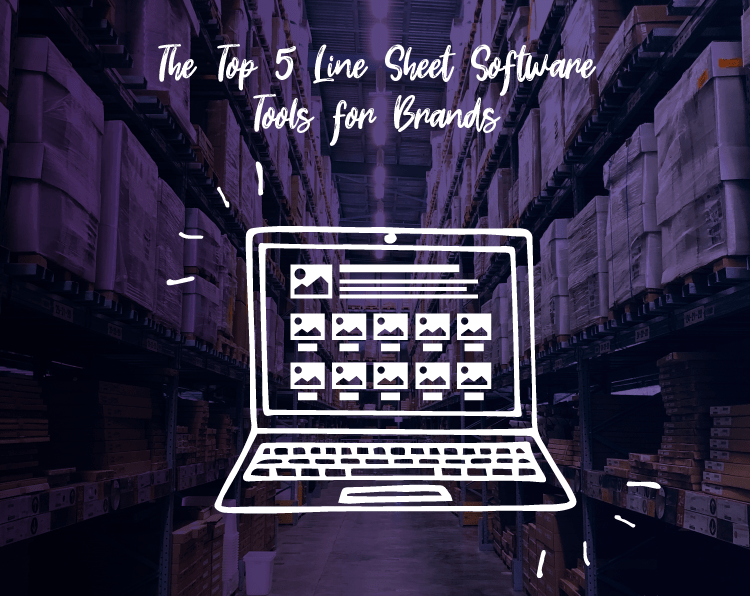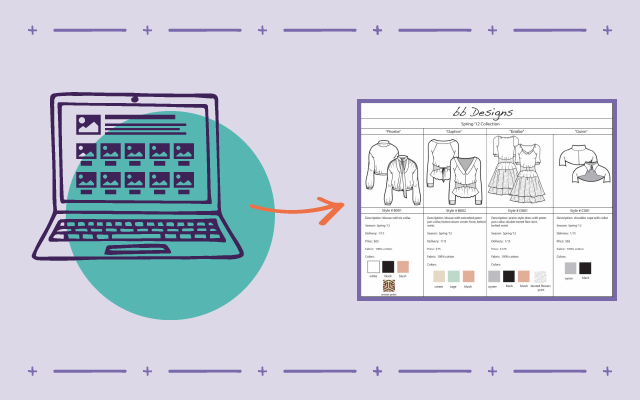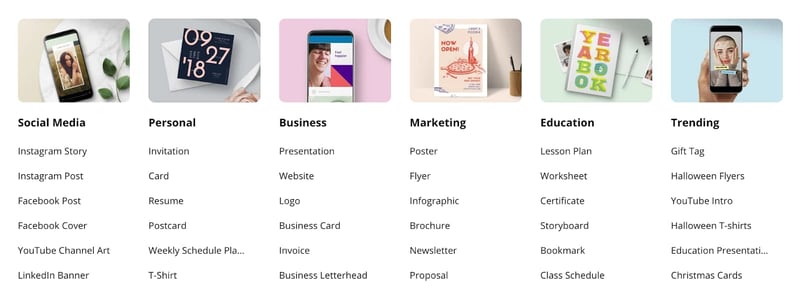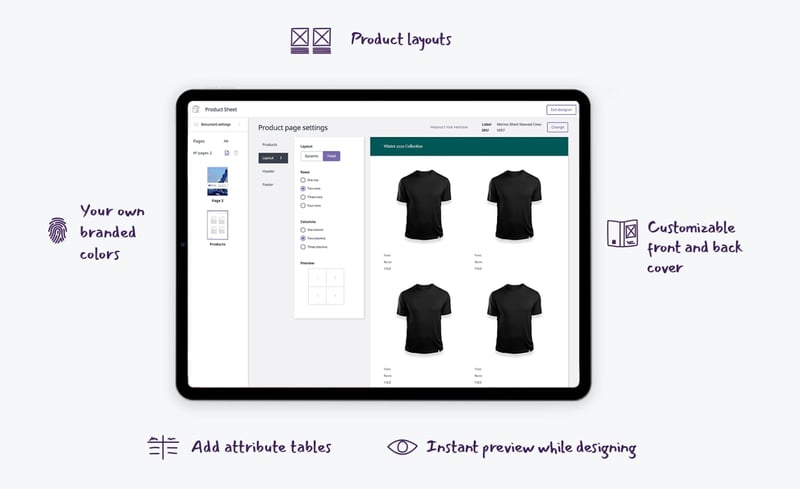The Top 5 Line Sheet Software Tools for Brands

Keep the good stuff coming
Subscribe to our blog newsletter and get monthly content that helps you manage product data smarter.
No spam. Just real value.
Today’s ecommerce brands have a lot of choices when it comes to software tools for making line sheets.
But there’s a common problem in the industry (in any industry where technology has advanced so quickly it’s been hard to keep up with, really). Many brands are using clunky, outdated line sheet creation methods, just because that’s what they’ve been using since a time when there weren’t so many slick, simple options available.
Now for the good news: There’s no reason to keep using obsolete line sheet software! We’re well into the digital age, and brands have more agency than ever to choose from a myriad of user-friendly, accessible, and affordable tools for every facet of their business, line sheets included.
So whether you’re looking for a line sheet software tool to replace a workflow that’s stuck in the 2010s, or you’re a new ecommerce brand building your first tool stack, we have all the information you need. Read on to learn all about what features are most important to look for in a line sheet software tool, as well as a list of some of the best software available today.
What To Look for in a Line Sheet Software Tool
The first step in choosing the right line sheet software tool for your brand is knowing what to look for in any potential tools you’re considering. We think these are the most essential features.
Direct Product Importing

At the very least, the line sheet software you choose should make your life easier, and that means no tedious data entry. It should be able to directly import products, their data, and their assets from wherever those are already organized, whether it’s your website, a product information manager, or a spreadsheet (though, in the digital age, let’s hope you’re using something more sophisticated than a spreadsheet — more on that below).
Being able to import products directly not only saves time, but it ensures that data is consistent across platforms. It removes the error prone nature of manual data entry. This might be the most important aspect of a line sheet software, so definitely look for a tool that makes this process as simple and streamlined as possible.
Ease of Use
In addition to simple, straightforward product importing, you want your line sheet software to be as easy as possible to use. Look for a tool that has an intuitive, user-friendly interface
One important part of a tool’s ease of use is being able to easily edit product details within the template. That means you should be able to change things like pricing, sizing, and product descriptions with just a few clicks of a mouse, inside the line sheet software tool — not by going back and editing your product information source, then re-importing the product you’ve made changes to.
While it’s important for it to be easy to make edits to product information in your line sheet tool, be aware that this can cause discrepancies between product information in your line sheets, and product information that you have stored internally or have distributed elsewhere. We have a tool that solves this problem — we’ll talk about that below.
Ability to Export In Multiple Formats
Another feature you’ll want to look for in your line sheet software tool is multiple options for exporting your finished line sheets. You’ll want to be able to have them printed in high-res, or export them in PDF formats so they can be emailed to potential customers directly. That flexibility is key when you’re looking for a line sheet tool that meets all the needs of a modern ecommerce brand.
Fully Customizable Templates and Sheets

The last vital feature for your line sheet software tool is the ability to fully customize every line sheet you create.
This means you should be able to fully customize any available templates, or start from scratch to create your own Powerpoint templates. You should also be able to add your own branding to everything you create, from your brand logo, to colors, to fonts that you use and any other customization that makes it clear these are line sheets for your brand.
But a part of customization that many brands don’t consider is the ability to tailor each line sheet for the customer who’s receiving it. In other words, your line sheet software should make it so simple and fast to create new line sheets, you should be able to make a new, fully customized set for every potential customer.
What Line Sheet Software Tools Do Today’s Ecommerce Brands Love?
First, a show of (virtual) hands.
Who here is using Microsoft Suite tools to create line sheets?
Hey, we get the temptation. They’re tools that most people have been using for years, if not decades. They’re familiar. And they probably, more or less, get the job done.
But creating your own line sheets in Microsoft Word or PowerPoint is by no means the easiest way. Odds are, you aren’t creating the best possible line sheets for your brand by clunkily arranging images in a Word doc.
This is why most established ecommerce brands need a new solution — because they’re still doing their line sheets like this (or using one of so many other outdated and obsolete technologies). If you want to instantly step up your line sheet game, try one of the tools below.
Photoshop or InDesign
Many ecommerce brands have graduated to using Adobe tools like Photoshop or InDesign to create their line sheets. But while this is a step up from Microsoft tools, it still isn’t ideal.
These are powerful tools that can be used to create all kinds of marketing and sales tools — not just line sheets. But they also come with a fairly steep learning curve. They’re complex pieces of software that aren’t for beginners.
And while they offer possibly the most advanced levels of customization of any line sheet software tool on the market, Adobe tools aren’t quick to use. Even with templates, there’s no automated importing of products, and making a quick edit to a single line sheet often means going to the source file, making a manual change, and then re-exporting the new sheet. Or worse — it means having to task a team of designers with doing that, because they’re the professionals most likely to have the skills needed to create line sheets with this software.
Canva

For a tool that comes with nearly as much customization ability, but is a little more streamlined and user-friendly than Adobe software, there’s Canva.
Canva is a free, web-based app that allows users to create all kinds of documents — not just line sheets. There’s also a large database of user-created templates that anyone can use.
A few problems, though: Canva also has a bit of a learning curve. It’s not as complex as Photoshop or InDesign, but creating truly eye-catching, professional level line sheets will take some serious practice.
And while there’s an extensive library of slick templates available (and plenty of tutorials on YouTube for how to create line sheets in Canva), there’s no actual section for line sheet templates, which can make them hard to find.
Linesheets or Brandboom
Linesheets is another web-based app, like Canva, but with a distinct advantage: It was made just for helping brands create line sheets.
This platform makes creating line sheets as simple as possible. You can customize templates, upload products or import them from your online storefront, create collections, incorporate your own branding, and download your line sheets as PDFs or send them straight to potential buyer’s using the site’s built-in email utility.
Brandboom is a similar platform, also web-based, that focuses on helping brands create stunning line sheets that impress all their potential buyers. It allows users to build a product catalog within the platform, and then instantly generate line sheets that can be printed, downloaded as PDFs, or sent to potential customers as virtual presentations straight from the platform.
It may seem like software like Linesheets or Brandboom offers everything you need. But there’s a better option out there.
Plytix: The Top Line Sheet Tool That Does It All
Plytix is the software tool that every brand needs to create its line sheets.
That’s because Plytix does everything that top line sheet tools can do: It allows you to directly import products from your catalog into a line sheet format; it lets you customize your templates; it allows you to export line sheets as PDFs, print them, or send them directly to retailers; and it automates the whole process, so you can have auto-generated line sheets ready to send to a potential customer in just minutes, with just a few clicks.

But Plytix is much more than a line sheet software.
Plytix is a product information management platform, which allows you to store and organize your product information in a single source of truth, accessible across your organization. In addition to line sheets, that product information can be exported to Branded PDFs, Brand Portals, and more.
Plytix is the all-in-one tool brands need to do everything their competition can do — but better.
Ready to see for yourself? Sign up for an account today.
Frequently Asked Questions

What if your product data actually worked for you?
We’ll show you how Plytix helps you stop fixing data—and start using it.
Related posts
Keep the good stuff coming
Subscribe to our blog newsletter and get monthly content that helps you manage product data smarter.
No spam. Just real value.





Think others should see this?
Go ahead and share it.